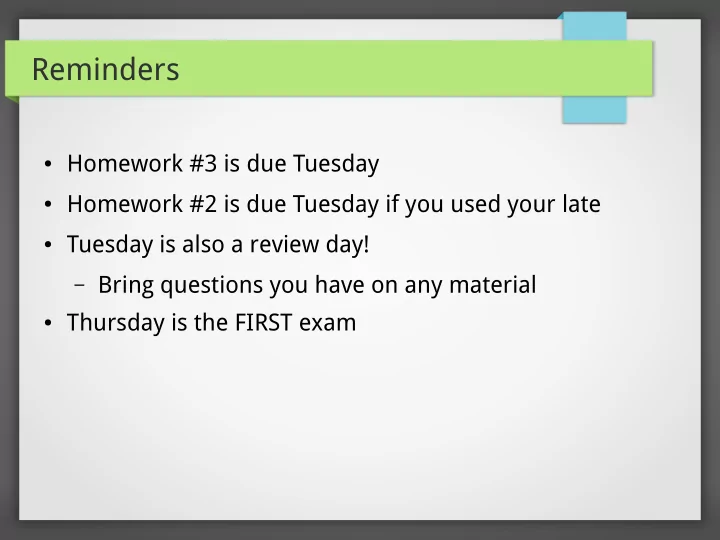

Reminders ● Homework #3 is due Tuesday ● Homework #2 is due Tuesday if you used your late ● Tuesday is also a review day! – Bring questions you have on any material ● Thursday is the FIRST exam
CMSC 203: Lecture 9 Functions (since we didn't get to it yet) Sequences, Series, and Cardinality
Functions ● Assigning elements of one set to another set (possibly the same) ● Example : Assigning set of students to set of grades ● This assignment is a function (also called mapping or transformation ) ● Functions are extremely important to computer science – Definition of discrete structures – Runtime analysis – Calculating values (input → output) – Understanding recursive functions
Defining Functions ● Function from A to B is assignment of exactly one element of B to each element of A ● Written as – Can be done as f(x) = x + 1 – Can also be done by f(Apple) = Tree ● b is a unique element, assigned by f to element a ● If f is a function from A to B, write “f : A → B”
Definitions If f is a function from A to B , and f(a) = b ● Domain : A is the domain of f ● Codomain : B is the codomain of f ● Image : b is the image of a ● Preimage : a is the preimage of b ● Range : Set of all images of elements of A Note: This is not to be confused with codomain – ● Maps : f maps A to B
Special Function Types ● One-to-One / Injunctive : f(a) = f(b) implies that a = b for all a and b in the domain – I.e., each image only has one preimage – or ● Onto / Surjective : Every element b B has element a A ∊ ∊ with f(a) = b – I.e., every element in the codomain is an image – ∀ y x(f(x) = y) ∃ ● One-to-One correspondence / Bijective : Function f is both, one-to-one and onto
Cardinality of Sets ● Two sets have the same cardinality if there is a one-to- one correspondence (bijunction) between the sets ● If there is a one-to-one function from A to B, |A| < |B| ● If a set is ininite, than |S| is not a number ● If an infinite set has same cardinality as Z+ then it is countable , otherwise it is uncountable
Function Operations ● Inverse Function – Denoted as f -1 – If f is a bijection, then f -1 (b) = a whenever f (a) = b – i.e., f -1 assigns to b the element a such that f (a) = b ● Composition – Let f and g be functions from B to C and A to B (respectively) – f(g(a)) = (f ○ g)(a) is the composition of f and g – Range of g must be a subset of the domain of f
Sequences ● Sequences are lists of ordered elements – Now order matters ● Can be finite or infinite – 1, 2, 3, 5, 8 – 1, 3, 9, 27, 81, …, 3 n , ... ● Formally, it is a function from N to some set S – a n is the n th term of the sequence
Important Sequences ● Geometric Sequence: , a ∈ R , r ∈ R – Initial term a and common ratio r – ● 2, 10, 50, 250, 1250, … ● Arithmetic Sequence: , d ∈ R , a ∈ R – Initial term a and common difference d – ● -1, 3, 7, 11, ...
Recurrence Relations ● Fibonacci sequence : f n = f n-1 + f n-2 , f 0 = 0, f 1 = 1 – 0, 1, 1, 2, 3, 5, 8, 13, 21, 34, ... ● Defined using previous terms: recurrence relations – Can solve using iteration – Start at intial conditions, and work to a n ( forward substitution ) ● Solve to express as a closed formula (in terms of n ) – a n = a n-1 + 3, a 0 = 2 can be expressed as a n = 2+3 n
Summations ● A summation of a sequence is the sume of all terms in series from a m to a n ● Written in the form: or ● is the index of summation , m is the lower limit , and n is the upper limit ● Normal arithmetic operations apply, such as sum of two summations
Useful Closed Forms
Recommend
More recommend